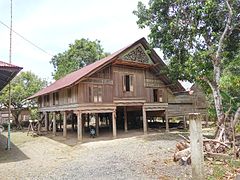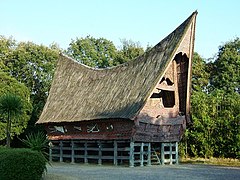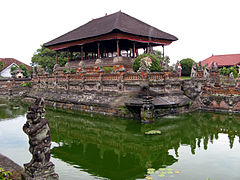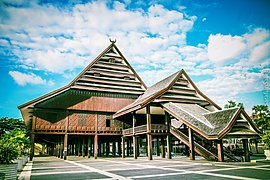Rumah adat

Rumah adat are traditional houses built in any of the
Ethnic groups in Indonesia are often associated with their own distinctive form of rumah adat.[2] The houses are at the centre of a web of customs, social relations, traditional laws, taboos, myths and religions that bind the villagers together. The house provides the main focus for the family and its community, and is the point of departure for many activities of its residents.[3] Villagers build their own homes, or a community pools its resources for a structure built under the direction of a master builder or carpenter.[2]
The vast majority of Indonesians no longer live in rumah adat, and the numbers have declined rapidly due to economic, technological, and social changes.
General form
With few exceptions, the peoples of the Indonesian archipelago share a common
The norm is for a post, beam and lintel structural system that take load straight to the ground with either
leaves, alang alang grass and rice straw.Traditional dwellings have developed to respond to natural environmental conditions, particularly Indonesia's hot and wet monsoon climate. As is common throughout
Examples
Examples of rumah adat include:
- Rumoh Aceh, is the largest and tallest type of traditional houses of Acehnese people. It has a wooden gabled roof, decorated with wood carvings of floral or geometric patterns on the exterior.
- Batak architecture (North Sumatra) includes the boat-shaped jabu homes of the Toba Batak people, with dominating carved gables and dramatic oversized roofs, and are based on an ancient model. Meanwhile, the Karo Batak house has a high roof, in the form of a combination of a gable or two gables crossed over a hip roof. Other Batak groups also have their own style of traditional housing.
- The Minangkabau of West Sumatra build the rumah gadang, distinctive for their multiple gables with dramatically upsweeping ridge ends.
- The homes of Nias peoples include the omo sebua chiefs' houses built on massive ironwood pillars with towering roofs. Not only are they almost impregnable to attack in former tribal warfare, but flexible nail-less construction provides proven earthquake durability.
- Mentawai Islands, with a rectangular shape and a verandah at each end.
- Malay traditional houses built on stilts of Sumatra, Borneo and Malay Peninsula. There are many styles of Malay houses; for example curved roof houses from the east coast of North Sumatra and Kampar (Riau), gabled roof houses with crossing edges forming "x" pinnacles on corners of the roof from Riau and Jambi, pyramidal styled pitched roof with a stepped floor from South Sumatra and multiple-level hip-roofed house from West Kalimantan.
- Nuwo Balak of Lampung, which means big house, has a roof whose ends are centred on a central point and is made of round logs arranged parallel and copper-plated. This house is used as the residence of the tribal chiefs.
- Rumah Kebaya is a one of Betawi traditional house. The main characteristic of this house is its wide terrace, which may serve to receive a visitor and as a place for relaxing.
- gabled roofcalled kampung style roof, made of thatched materials (ijuk black aren fibres or hateup leaves) with weaved bamboo wall and structure built on short stilts. The more elaborate overhanging gabled roof is called julang ngapak.
- Unlike most South East Asian vernacular homes, Javanese omah are not built on piles, and have become the Indonesian vernacular style most influenced by European architectural elements.
- Tanean Lanjhang, which means a long yard, is a traditional Madurese house which is a collection of houses consisting of several families who are still in one family bond.
- Traditional Balinese homes are a collection of individual, largely open structures (including separate structures for the kitchen, sleeping areas, bathing areas and shrine) within a high-walled garden compound.
- Dayak people traditionally live in communal longhouses that are built on piles. The houses can exceed 300 m in length, in some cases forming a whole village. While baluk roundhouse of Bidayuh Dayak is built on very high stilts with an iconic conical roof.
- The Bubungan Tinggi, with their steeply pitched roofs, are the large homes of Banjarese royalty and aristocrats in South Kalimantan.
- The Sasak people of Lombok build lumbung, pile-built bonnet-roofed rice barns, that are often more distinctive and elaborate than their houses (see Sasak architecture).
- Dalam Loka of Sumbawa is the former residence of the sultan of Sumbawa with an elongated twin stilt house shape and two levels of gabled roofs.
- Bugis-Makassar saoraja or balla houses are stilt houses, with gabled roofs and have a distinctive gable cover called timpalaja with a certain number of arrangements as a symbol of the social status of the homeowner.
- Malige of Buton has a similar appearance to the Bugis-Makassar house but with a two-tier level of the gable roof.
- The , houses built on piles and dwarfed by massive exaggerated-pitch saddle roofs.
- Walewangko is the residence of the Minahasan traditional elders. It has two stairs, located on the left and right of the front of the house.
- People of Flores are known for their traditional house that has a trapezoidal roof. This house is called sa'o by the Ngada people or mosalaki by the Ende-Li'o people.
- Lopo of Alor has a pyramid-shaped roof and is supported by several pillars made of wood.
- Uma Kalada of Sumba have distinctive thatched "high hat" roofs and are wrapped with sheltered verandahs.
- Ume Le'u from Atonipeople. It consists of two buildings, namely lopo and ume kbubu. Lopo has a conical roof without walls, while ume kbubu has a rounded shape, has no windows, and only has one door. Meanwhile, the tribal chiefs live in the conical-roofed sonaf house.
- thatcheddome roofs.
- The Tobati and Sentani people are known for their cone-shaped houses called kariwari or khombo which are built around the shores of Lake Sentani.
- Rumsram house of the Biak Numfor people is square in shape with an overturned boat-shaped roof.
- Mimika people of Central Papua people have a traditional house called karapao, which has many doors and mats made of forest pandanus.
- Asmat people of South Papua have a stilt house called jew which is rectangular in shape and functions as a gathering place for men who are not married or who are still single.
- Rumah Adat
-
Rumoh Aceh, Aceh
-
A traditional Batak Toba house, North Sumatra
-
Karo house, North Sumatra
-
Rumah Gadang, West Sumatra
-
Bangkinang Malay house, Riau
-
Rumah Kebaya, Jakarta
-
Sundanese Kampung house, West Java
-
Balinese pavilion, Bali
-
Rumah Bubungan Tinggi, South Kalimantan
-
Bugis house, South Sulawesi
-
Houses in a Torajan village, South Sulawesi
-
Sumba house, East Nusa Tenggara
-
Mbaru Niang house, East Nusa Tenggara
Decline
The numbers of rumah adat are decreasing across Indonesia. This trend dates from the colonial period, with the Dutch generally viewing traditional architecture as unhygienic, with big roofs that sheltered rats.
Exposure to the market economy made the construction of labour-intensive rumah adat, such as the Batak house, extremely expensive (previously villages would work together to construct new homes) to build and maintain. In addition, deforestation and population growth meant that the hardwoods were no longer a free resource to be gathered as needed from nearby forests, but instead a too-expensive commodity.[9] Combined with a general appetite for modernity, the great majority of Indonesians now dwell in generic modern buildings rather than traditional rumah adat.[citation needed]
In areas with many tourists, such as the Tanah
Contemporary adaptation

During the colonial

This period also saw the pride and desire to showcase the cultural diversity of the colony through showcasing the vernacular architecture of the archipelago. In 1931, during

Buildings are sometimes built with modern construction techniques that include stylistic elements from rumah adat, such as The House of the Five Senses in the Efteling, a building modeled on the Minangkabau rumah gadang. In the colonial period some Europeans constructed homes according to hybrid Western-adat designs, such as Bendegom, who built a 'transitional' Western-Batak Karo house.[14]
In numbers of places, elements or ornaments of rumah adat has become the regional identity of provinces or regencies (

It has been noted that the traditional wooden houses are generally more earthquake-resistant than modern brick designs, although they are more vulnerable to fire. The construction of modern concrete framed and brick walled rumah adat has undermine the very characteristic of traditional wooden house, which is its flexibility to absorb shock-waves generated by an earthquake. These concrete rumah adat-style building often can not withstand earthquake and collapsed, like those buildings collapsed in
See also
- Architecture of Indonesia
- Javanese traditional house
- Balinese traditional house
- Rumah gadang
- Malay houses
- Bahay kubo
- Bahay na Bato
- Torogan
Notes
- ISBN 9789971692926.
- ^ a b c Dawson (1994), p. 10
- ^ a b Dawson (1994), p. 8
- ^ a b c d The Oxford Companion to Architecture, Volume 1, p. 462.
- ^ Dawson (1994), p. 12
- ^ Dawson (1994), pp. 10-11
- ^ Dawson (1994), p. 11
- ^ a b Nas, p. 348
- ^ a b Nas, p. 347
- ^ a b Transformation of Building Form: Development of Traditional Dwelling of the Ngada, Central Flores Island - Toga H Pandjaitan Archived 2011-08-10 at the Wayback Machine
- ^ Nas, p. 352
- ISBN 978-3-658-11605-7.
- ^ National Museum of Indonesia, Directorate General of Culture, Ministry of Education and Culture of the Republic of Indonesia.
- ^ Nas, p.349
Bibliography
- Reimar Schefold, P. Nas, Gaudenz Domenig, Indonesian Houses: Tradition and Transformation in Vernacular Architecture, 2004, National University of Singapore Press, Singapore, ISBN 9789971692926
- Dawson, B., Gillow, J., The Traditional Architecture of Indonesia, 1994 Thames and Hudson Ltd, London, ISBN 0-500-34132-X
- Schoppert, P., Damais, S., Java Style, 1997, Didier Millet, Paris, 207 pages, ISBN 962-593-232-1
- Wijaya, M., Architecture of Bali: A source book of traditional and modern forms, 2002 Archipelago Press, Singapore, 224 pages, ISBN 981-4068-25-X
- Peter JM. Nas, The House in Indonesia













